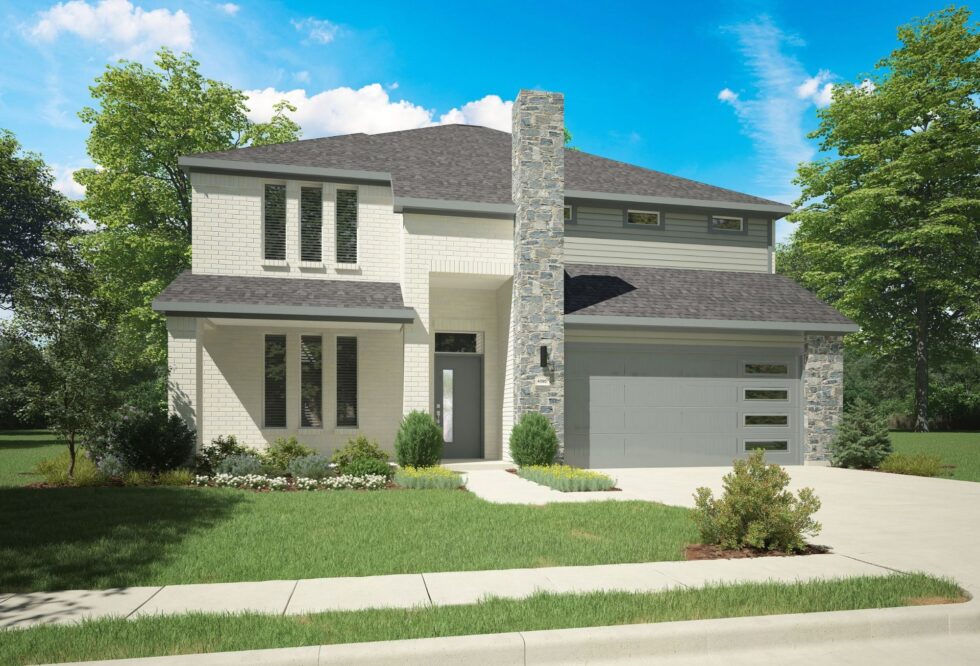In a design for the South Asia Human Rights Documentation Centre in New Delhi, local firm Anagram Architects was drawn to brick as a cost-effective and efficient choice, since the project for the NGO needed to be created within a tight budget and timeframe for construction. Brick is a commonplace and inexpensive material in the area. The 200m2 building employs brick in a large porous wall that acts as a brise-soleil along the sunny south-western side of the building.
"We felt that it just shouldn’t really be a monolithic brick wall," says Madhav Raman, a partner at Anagram. City life in India is… "all about being connected to the street… so a lot of our boundaries and barriers are porous."
Dynamic efficiency
Designed to evoke fabric rippling in the wind, the brickwork features a playful vertical twirling pattern created by rotating a repeating module of six bricks.
The centre of the wall is the most porous section, and to strengthen it, the designers replaced some bricks with concrete support beams along each floor slab.
The architects relied heavily on input from their skilled masons to refine their original CAD design to make it buildable.
See Also:
"How we felt it would be built and how it actually got built were universes apart," Raman recalls.
How well do you really know your competitors?
Access the most comprehensive Company Profiles on the market, powered by GlobalData. Save hours of research. Gain competitive edge.

Thank you!
Your download email will arrive shortly
Not ready to buy yet? Download a free sample
We are confident about the unique quality of our Company Profiles. However, we want you to make the most beneficial decision for your business, so we offer a free sample that you can download by submitting the below form
By GlobalDataThe masons were initially sceptical about the unconventional twirling pattern, because it made it impossible to drop a plumb line to check the vertical alignment from course to course. The architects and masons collaborated in coming up with a solution: creating plywood triangular wedges that they used to ensure that the angle of rotation was the same in every course.
The wall is not only visually dynamic, it boosts the building’s energy efficiency. Summers in New Delhi get extremely hot, so the brise-soleil acts as an important shield against solar gain. It shades a stairway and toilet stack, which form a thermal "buffer zone" protecting the office space, which is behind a second wall.
In India, brick tends not to be as ecofriendly a material as it could be, because of the manufacturing process, according to Raman.
"There’s a lot of heat released; there’s a lot of residue; there’s a lot of polluting happening around brick kilns," he explains.
However, he notes one advantage of brick is its modularity, which helps boost its sustainability. You don’t really waste material, you use exactly as much as you need.
Liechtenstein: serene hues
The son of a mason, architect Hansjörg Göritz first became acquainted with brick through its use in vernacular architecture in Lower Saxony, where he grew up. When his eponymous Berlin and Hannover-based firm tackled a project to design two buildings and grounds for Liechtenstein’s parliament in the capital of Vaduz, the architects used vast amounts of monochromatic brick, to create a sense of cohesion between all the elements. The yellow ochre hue of the brick harmonises well with older stucco buildings nearby.
The competition-winning project is 13,800m2 and includes a building with a pointed roof where parliament meets, a long, low building for administrative offices and other functions, and a public square, terrace and garden.
Around 680,000 bricks cover a variety of exterior and interior spaces, including a conference room and subterranean garage. The architects chose the märkischer bond, a pattern of two long bricks alternating with one short one.
The design imparts a sense of serenity, due to the geometrically simple volumes and warm hue of the brick. But despite the seeming simplicity, the design was carefully considered, down to small details of the mortar that joins the bricks.
"The horizontal mortar joints are twice as thick as the generic mortar joints," Göritz explains, creating a better proportional relationship between the brick and mortar. "We use a rather rough mortar, and we achieve that by using a large grain for the sand. The crafted mortar joint becomes the rough and very playful surface which the sunlight will play with later on, and that makes the entire brickwork, especially on larger surfaces, quite vivid."
His firm chose brick partly for sustainability reasons, and the bricks were kilned relatively close by in Switzerland. Though facing brick isn’t commonly used in the Vaduz area, Göritz realised the material would be well suited for the local weather that can be moist and frosty; he’d seen it used in some parts of Germany with a similar climate. The bricks were custom-made to be sufficiently dense and sturdy to stand up to those weather conditions.
Brick isn’t an attention-grabbing material, but that suits Göritz’s minimalist instincts. It might be more in vogue to create "flashy signature pieces, and that usually happens with shimmering materials on the outside, by which we wrap rather traditional load-bearing constructions," he says.
But for him, using exposed brick is more appealing, as a ‘true and honest’ form of architecture. The downside is that there’s no hiding any mistakes, so architects and bricklayers alike need to have a certain level of expertise for good results.
"Nowadays, it is more and more difficult to find the right craftsmen who have learned their trades very well," Göritz says.
As hand labour is increasingly replaced by digital design and fabrication techniques, robot bricklayers might become the wave of the future.
Helsinki: past and future
In the 31,700m2 University of Helsinki City Centre Campus Library building under construction, a brick design along the façade also helps reduce solar gain by providing shade. Scheduled to open in September 2012, the new building will be the largest academic library in Finland.
The brick forms a grid-like pattern interspersed with arches that frame "reading balconies" visible through glass windows, says Vesa Oiva, a partner at local firm Anttinen Oiva Arkkitehdit, which designed the library. The grid-like pattern gives the building "a sense of scalelessness".
The architects decided to use brick partly because there are a number of older brick buildings nearby, so the material evokes a connection to the past. However, they created a distinctly modern design for the brickwork to simultaneously evoke a sense of looking forward.
"Today, the notion of the academic library combines elements of past, present and future," Oiva says. "As a material, brick used in a contemporary way represents this principle of an academic library."
Not only does the design evoke the future; the brick will weather, age and evolve. Its longevity is one reason the firm decided upon its use.
"It’s really long-lasting and doesn’t need so much service during the lifecycle," Oiva says.
"Exposed or facing brick can [reveal] a wonderful quality of aging well," Göritz adds. "I’m talking about patina… The older it gets, the more beautiful it becomes."
For more on this topic, see "I, Bricklayer: Construction Robotics" on Design Build Network: http://tiny.cc/L4oik
This article was first published in our sister publication The LEAF Review.





